Moray Estate
The Moray Estate in Edinburgh was an exclusive early 19th century building venture attaching the west side of Edinburgh's New Town.
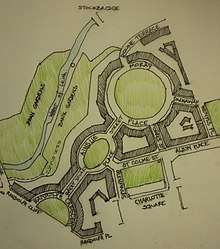

Built on an awkward and steeply sloping site, it is a masterpiece of urban planning. With generous plots accommodating huge townhouses it has accommodated the rich and famous from its outset.
Background
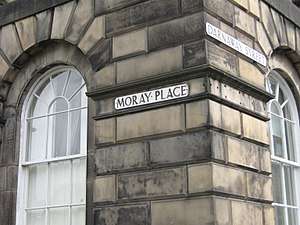
The ground, extending to 5.3 hectares, was acquired in 1782 by the 9th Earl of Moray from the Heriot Trust.[1] The land contained Drumsheugh House and large gardens lying between Charlotte Square and the Water of Leith.
In 1822 his son, Francis Stuart, 10th Earl of Moray, commissioned the architect James Gillespie Graham to draw up plans to build over 150 huge townhouses on the land. The houses were set on large plots, even by surrounding New Town standards, and were complemented by a series of private gardens, most notably on the slopes of the Water of Leith.
Sales were begun (from plan) by auction on 7 August 1822. Over and above the cost of the plot, purchasers agreed to a build cost of £2000 to £3000 (depending on the plot) and an annual fee of £30. A "penalty clause" also imposed a fine of £100 on buildings not completed within 30 months. If comparing these prices to the norm, even for the affluent New Town this was perhaps ten times more than might have been expected. While the houses were among the largest ever built, this clearly guaranteed an exclusivity from the outset.[2]
While the majority of plots sold well and quickly (some of the corner plots were less popular, mostly being completed in the 1850s) the scheme as a whole was completed in 1858.
As one of the most affluent areas in Edinburgh, it set a trend. Glazing was changed to one-over-one format over almost the entire estate by 1950, but when architectural conservation came to the fore in the 1970's, it was one of the first areas to almost wholly restore windows to their original form.
Most basements throughout the estate are now separate properties and many of the blocks are divided into flats.
Gardens
.jpg)
The Bank Gardens between the estate and the Water of Leith extend to 4.1 acres and slope steeply and were raised further to level the estate. A virtually inevitable landslip occurred at the back of the Ainslie Place feus in 1825 and had to be rectified by the addition of structural arches by James Jardine. A further landslip in the south-west corner in 1837 required further arches and these were then re-invented as a high level walkway leading to Dean Bridge. However the southern section of the Bank Gardens did not become fully operational until 1840.[1]
Over and above the Bank Gardens two other substantial private gardens were created: Moray Place Gardens and Ainslie Place Gardens. Of these Moray Place Gardens is sufficiently large and sufficiently screened to provide tennis courts and croquet lawns.
The several garden areas remain the private joint property of the Moray Estate owners (often called the Moray Feuars).
Moray Place

Appearing as a circle but actually a duodecagon this is the largest and grandest space within the plan. Technically it is symmetrical around its northwest/southeast axis, but the scale of the form and central gardens makes this impossible to interpret on the ground, and this is only visible from above. Although rear mews were standard at the time of building, the layout only permitted mews on the north-east side (now known as Gloucester Lane).
Lord Moray took one of the largest and most prominent houses: 28 Moray Place. Other notable residents included Alexander Kinnear, 1st Baron Kinnear (2), George Deas, Lord Deas (3), Sir David Baxter of Kilmaron (5), Charles Dundas Lawrie (5), John Learmonth (6), John Sinclair, 1st Baron Pentland (6), Charles Hope, Lord Granton (12), Robert MacFarlane, Lord Ormidale and his son George Lewis MacFarlane (14), John MacGregor McCandlish (18), John Hope, Lord Hope (20), Francis Brown Douglas (Lord Provost) (21), Bouverie Francis Primrose (22), Francis Jeffrey, Lord Jeffrey (24), George Young, Lord Young (28), Andrew Coventry (29), Thomas Charles Hope (31), Sir James Miles Riddell (33), John Fullerton, Lord Fullerton (33), Baron Hume (34), Robert Kerr, Lord Kerr (38), Robert Christison and his son Sir Alexander Christison (40), William Thomas Thomson and his son Spencer Campbell Thomson (41), Thomas Jamieson Boyd (Lord Provost) (41), James Skene (46), Sir James Wellwood Moncreiff, 9th Baronet (47), John Corse Scott (48), Rev George Coventry (49)[3]
Ainslie Place
Named after the Earl's wife, Margaret Jane Ainslie, daughter of Col. Sir Philip Ainslie of Pilton,[4] Ainslie Place stands in the centre of the scheme. The format is an oval circus laid on a south-west to north-east axis, between the two halves of Great Stuart Street.
The scheme has always been popular with Scottish law lords and eminent physicians. Notable residents include John Millar, Lord Craighill (2), William Blackwood (3), Edward Maitland, Lord Barcaple (3), John MacWhirter (physician) (4), John Cowan, Lord Cowan (4), Mark Napier (historian) (6), Reginald Fairlie (office at 7), John Duncan (surgeon) (8), Alexander Bruce (neurologist) (8), James Ivory, Lord Ivory (9), James Gregory and his eminent sons Donald, William, Duncan and James all at 10, Sir William Edmonstone (11), George Cranstoun, Lord Corehouse (12), John Hay Forbes, Lord Medwyn (17), James Spence (surgeon) and George Burnett, Lord Lyon (21), Neil Kennedy, Lord Kennedy (22), Francis Cadell (artist) and his actress sister Jean Cadell (22), John Rankine (legal author) (23), Dean Edward Ramsay and his brother Admiral Sir William Ramsay (23) in later life (see Darnaway St), Very Rev James Robertson (25)
Randolph Crescent

This street forms the entrance into the estate from the south. Randolph Crescent Garden was originally retained by Lord Moray and Graham's plan showed a large mansion in the centre, probably as a replacement to Drumsheugh House. It was ultimately decided this was not a good location to build.[2]
The elevated ground level in the central garden is partly due to the placing of excess soil here during original construction. It facilitated a large air raid shelter being constructed here during the Second World War.[5]
Notable residents include Edward Gordon, Baron Gordon of Drumearn (2), William Mackintosh, Lord Kyllachy (6), Robert Smith Candlish (9), Erskine Douglas Sandford (11), William Campbell, Lord Skerrington (12), and James Stevenson and his daughters Flora and Louisa (13).
Randolph Cliff
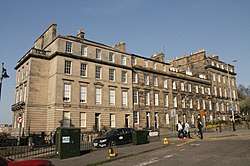
The dramatic entrance to the Moray Estate from Dean Bridge begins with Randolph Cliff, which stands dramatically over the Water of Leith far below. It was one of the final sections to be completed (and quite an engineering feat) and is laid out as flats rather than houses. The corner block as a complex stair to access the main stair, unlike any other block on the estate.
Randolph Place
Somewhat detached from the rest of the estate, Randolph Place never had the same allure as housing and from the outset seems to have attracted office use.
Two famous architects had their offices here: Alexander Hunter Crawford at 10 and Reginald Fairlie at 14.[6]
Great Stuart Street
Split into two halves by Ainslie Place, this street is named after the Earl's family name of Stuart and his additional title of Baron Stuart (granted in 1796). It forms the links between the main sections of the estate.
Notable residents include Dr Alexander Monro (1), Sir Robert Christison (3), Harold Stiles (9), John Murray, Lord Murray (11), Lt Gen Thomas Robert Swinburne (13), James Warburton Begbie (16), William Edmonstoune Aytoun (16) and William Henry Playfair (17).
Doune Terrace
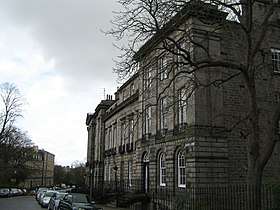
Named after the Earl's country estate of Doune and family title (from 1581) of Lord Doune, this street links Moray Place to the lower streets around Stockbridge.
Notable residents include James Craufurd, Lord Ardmillan (2) and Thomas Balfour, James Kinnear and James Pitman, Lord Pitman (9) .
St Colme Street
This street is named after the family title of Lord St Colme (granted in 1611) and links Ainslie Place to Queen Street.
Notable residents include George Angus (architect) (1), Thomas Guthrie Wright (6), Helen Kerr (6), and Andrew Rutherfurd, Lord Rutherfurd (9).
Harold Tarbolton had his office at no.4 and was later joined by Matthew Ochterlony.
Lord Rutherfurd employed William Notman to remodel his building in 1835, soon after it was built.
Albyn Place
Named after Glen Albyn on the Aberdeenshire estates, this short section is a continuation of St Colme Street linking to Queen Street.
Notable residents include William Forbes Skene founded Skene Edwards WS (offices at 5), Aeneas James George Mackay (7), David Mure, Lord Mure (8), Prof Thomas Stewart Traill (10), Prof David Low (11)
Darnaway Street
Named after the family seat of Darnaway Castle, this short street links Moray Place to Heriot Row, then and still an exclusive Edinburgh address.
Notable residents include Thomas Duncan (painter) (1), William Kirk Dickson (3), George Joseph Bell (6), Edward Ramsay (7), Archibald Campbell Swinton and his son George Swinton (7), John Steell (11) and Robert Matthew (12).
Forres Street
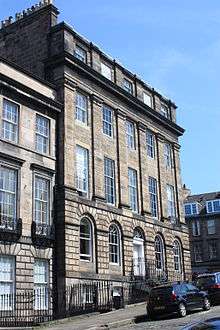
Named after the family estate of Forres, this street connects Moray Place to Charlotte Square.
Notable residents include Thomas de Quincey (1), Thomas Chalmers (3), Robert Omond (4), John Montgomerie Bell (4), Ramsay Traquair (4), Sir Alexander Kinloch (5), David Paulin (6) and Archibald Fleming (9).
Glenfinlas Street
Named after the family rural estate of Glenfinlas in the Trossachs, this short street formed the north-west connection to Charlotte Square and appears a completion of the square. Due to boundary/ownership issues between the Moray Estate and Charlotte Square the final block was not completed until the late 20th century (the only block built as an office).
Notable residents include John Hughes Bennett (1).
Wemyss Place
Named after the Earl of Moray's step-mother, Lady Margaret Wemyss, daughter of David Wemyss, 4th Earl of Wemyss[7] Wemyss Place is peripheral to the estate and visually links more to Queen Street and Heriot Row. It is one of the few sections built with a mews (accessed through a central pend). The central block was the headquarters of Edinburgh's Home Guard in the Second World War and rather ridiculously had to be painted in camouflage colours (making it very obvious). Repainted grey after the war it was only restored to natural stone in the late 20th century.
Notable residents include George Smith (Scottish architect) (8), William Guy (dentist) and John Smith (dentist) (11)
References
- Buildings of Scotland: Edinburgh by Gifford, McWilliam and Walker
- "History – Lord Moray's Feu".
- Edinburgh Post Office Directories 1835 to 1910
- "Person Page". www.thepeerage.com.
- Edinburgh: location of air raid shelters 1940
- Edinburgh Post Office Directory 1910
- "Moray, Earl of (S, 1561/2)". www.cracroftspeerage.co.uk.